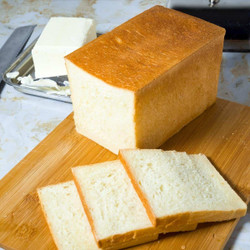Liquid ingredients - Ensure milk is warm, not hot (about 110 F). In a small bowl add the milk, yeast, sugar, and egg. Stir and set aside to foam for 5 mins.Pro tip - Instant yeast does not need to be activated but I like to ensure my yeast is good and working for me. You may choose to add all ingredients directly to the flour.
Dry ingredients - In the large bowl of a stand mixer, with the dough hook attachment combine the flour and salt. Then, add the yeast mixture. Combine with a wooden spoon or rubber spatulaPro tip - If you do not like kneading, I highly recommend using a stand mixer with the hook attachment.
Combine- Add the yeast mixture to the flour mixture and combine on medium-high speed for about 3 minutes scraping the sides of the bowl as necessary. Pro tip - Avoid the temptation to add more flour. We want soft, light, and fluffy bread, and this is only possible when the dough is soft, elastic, yet slightly sticky.
Knead - Once all the flour is incorporated, knead the dough for 8 to 10 minutes on medium speed until smooth. The dough will be soft and sticky.Pro tip - A soft and sticky dough is a light and airy bread so don't add more flour.
Butter - Next, add the soft room-temperature butter a little at a time. knead again for another 10 to 12 minutes until smooth and elastic.Pro tip - When you add the butter it will seem like the dough is falling apart. Trust the process and keep kneading. It will become smooth and shiny.
Bowl - Remove the dough from the mixer bowl onto a lightly floured surface. Shape it into a ball. Place in an oiled bowl. Pro tip - Using a flexible bread scraper does a good job of removing the sticky dough from the bowl.
Proof - Cover with plastic wrap or clean kitchen cloth. Leave to rise in a warm place for about an hour until doubled in volume.Pro tip - In winter, you may need 90 minutes or more. But in summer, the dough may double in 45 minutes. If you can't attend to it at that moment, de-gas, reshape, and let double in volume again.
Shape - When the dough is doubled in volume invert the risen dough onto a lightly floured surface. Start to roll like a jelly roll. Fold from the top to the center then again once more towards the end. Pinch the seams together.Pro tip - the idea is to fold the dough into a nice tight package. Folding helps strengthen the gluten strands and prevents loose floppy bread.
Proof - Place into a buttered Pullman loaf pan seam side down. Cover the loaf pan with plastic wrap or a clean kitchen cloth. Let rise in a warm place for about 45 minutes until almost 2 inches from the top rim of the loaf pan.
Cover - Once you see your dough is almost halfway up the sides – spray the cover of the Pullman pan lid and place it on.Pro tip - you want to place the lid on before it rises to the top so you don't ruin the rise.
Oven - Once you see your dough is almost halfway up the sides preheat the oven to 380°F / 190°C / Gas Mark 5 for at least 20 minutes.
Bake - Place the loaf pans on a baking sheet and into the oven. Bake - the 13-inch loaf for about 45 to 50 minutes, - the 9-inch loaf for about 25 to 30 minutes, - and the 7-inch loaf for about 20 to 25 minutes. Pro tip - The bread is done - when you tap the bottom of your loaf and you will hear a hollow sound (or the internal temperature registers between 160° to 180°F on an instant-read thermometer.
Cool - Partially open the lid and let it cool for 10 minutes - before you invert it onto a cooling rack. Cover it with a clean kitchen towel for 5 minutes to keep soft. Pro tip - Wrapping the bread in a kitchen cloth will let the steam cool in the bread keeping it soft.
Note - Always let bread rest for at least an hour before you cut it - this is the hardest part!! But, it will prevent the steam from escaping and making the bread dry.
